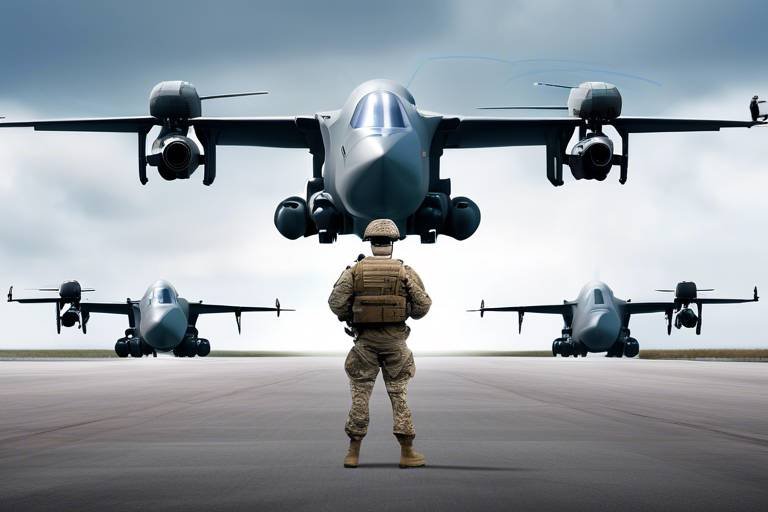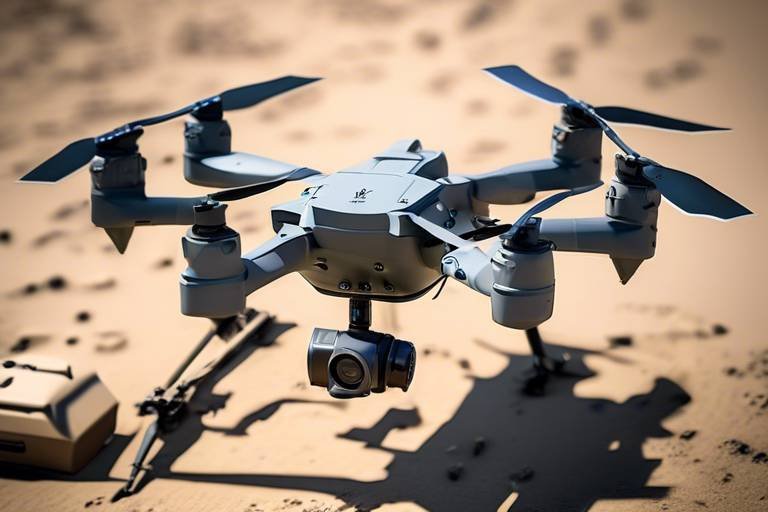Top Developments in Military AI-Based Decision Making
In recent years, the integration of artificial intelligence (AI) into military decision-making processes has transformed the landscape of modern warfare. With the ability to analyze vast amounts of data and provide actionable insights, AI technologies are becoming indispensable tools for military leaders worldwide. This article explores the latest advancements in AI applications within military decision-making, highlighting their implications, benefits, and the challenges faced by armed forces as they adapt to this new technological frontier.
One of the most significant developments in military AI is its integration into command structures. Traditional military hierarchies, often characterized by rigid protocols and slow decision-making processes, are evolving to embrace AI technologies. By utilizing AI, commanders can enhance their decision-making efficiency and effectiveness, allowing them to respond more rapidly to dynamic battlefield conditions. However, this shift does not come without challenges. Resistance from traditionalists who may view AI as a threat to established command hierarchies can hinder its adoption. The key to overcoming these obstacles lies in demonstrating the value of AI in improving operational outcomes, thereby fostering a culture that embraces innovation.
In the heat of battle, timely decision-making can mean the difference between victory and defeat. AI systems excel at processing vast amounts of information in real-time, enabling military leaders to gain actionable insights quickly. For instance, during an operation, AI can analyze data from various sources—satellites, drones, and ground forces—to provide a comprehensive overview of the battlefield. This capability allows commanders to make informed decisions based on the most current data available, significantly enhancing their situational awareness.
Another exciting aspect of military AI is its use of predictive analytics. By leveraging historical data and advanced algorithms, AI tools can forecast potential outcomes and scenarios. This predictive capability aids commanders in strategic planning and operational readiness, allowing them to anticipate enemy movements and prepare accordingly. For example, if AI predicts a potential ambush based on troop movements, commanders can adjust their strategies to mitigate risks. This proactive approach not only enhances safety but also increases the likelihood of mission success.
AI-driven scenario simulations are revolutionizing how military leaders prepare for combat situations. These simulations allow commanders to visualize various combat scenarios, enhancing their preparedness and strategic foresight. By creating a virtual environment where different strategies can be tested, military leaders can identify the most effective approaches before engaging in actual combat. This not only saves time and resources but also reduces the risk of casualties.
Furthermore, AI-based risk assessment models play a crucial role in evaluating potential threats and vulnerabilities. By analyzing data from multiple sources, these models help military planners make more informed and calculated decisions. For example, if an AI system identifies a high probability of a cyber-attack on critical infrastructure, military planners can implement countermeasures to protect their assets. This analytical capability is vital in today’s complex and unpredictable security environment.
The reliance on autonomous systems is steadily increasing in military operations. Drones and robotic vehicles are becoming essential tools, enhancing decision-making speed and accuracy in combat situations. These systems can operate in environments that are too dangerous for human soldiers, gathering intelligence and executing missions with minimal human intervention. However, the integration of autonomous systems also raises questions about control and accountability, which must be addressed to ensure responsible use.
As military AI technologies advance, so do the ethical implications surrounding their use. Questions of accountability, bias in algorithms, and the moral responsibilities of employing autonomous systems in warfare are at the forefront of this discussion. For instance, if an AI system makes a decision that results in civilian casualties, who is held accountable? These ethical dilemmas necessitate a robust framework for the responsible use of AI in military operations.
Establishing accountability and oversight mechanisms in AI decision-making processes is essential to prevent unintended consequences. Military organizations must develop clear guidelines that outline the responsibilities of human operators and the AI systems they employ. This ensures that human judgment remains central to critical decisions, particularly those involving life and death.
Finally, the current landscape of international regulations governing military AI applications is still evolving. As nations race to develop and implement AI technologies, establishing global norms and agreements presents a significant challenge. The rapid pace of technological advancement often outstrips the ability of regulatory bodies to keep up, leading to potential conflicts and ethical dilemmas on the battlefield.
- What is the primary benefit of using AI in military decision-making?
AI enhances the speed and accuracy of decision-making by processing vast amounts of data in real-time, allowing commanders to respond swiftly to changing battlefield conditions. - Are there ethical concerns associated with military AI?
Yes, ethical concerns include accountability for AI decisions, potential biases in algorithms, and the moral implications of using autonomous systems in warfare. - How does predictive analytics improve military operations?
Predictive analytics helps military leaders anticipate enemy actions and prepare strategies accordingly, leading to better outcomes in missions. - What role do autonomous systems play in modern warfare?
Autonomous systems, such as drones and robotic vehicles, enhance operational capabilities by performing tasks in high-risk environments without endangering human lives.
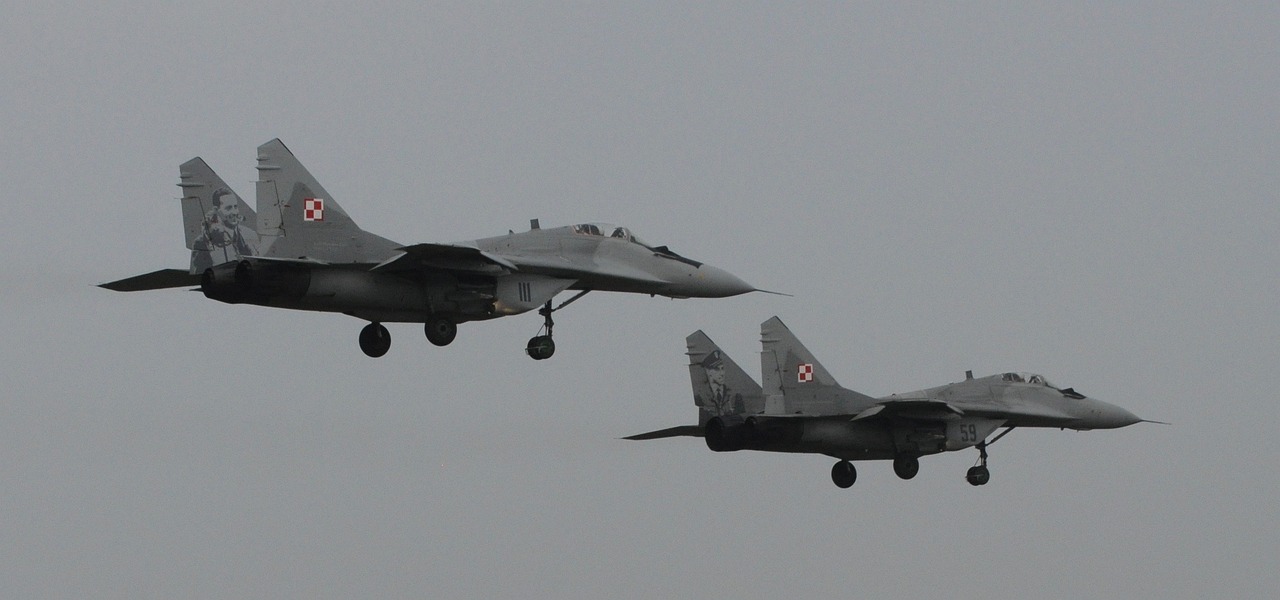
AI Integration in Command Structures
The integration of artificial intelligence (AI) into military command structures is not just a trend; it’s a revolutionary shift that is transforming how armed forces operate. Imagine a battlefield where decisions are made not just based on human intuition but also on data-driven insights processed at lightning speed. This is the reality that AI is ushering in. By harnessing the power of AI, military leaders can enhance their decision-making efficiency and effectiveness, but this comes with its own set of challenges.
One of the most significant benefits of AI integration is the ability to analyze vast amounts of data in real-time. Traditional command structures often rely on hierarchical decision-making processes that can be slow and cumbersome. In contrast, AI can process information from various sources—such as reconnaissance drones, satellite imagery, and intelligence reports—almost instantaneously. This means that commanders can receive actionable insights at a moment's notice, allowing them to make informed decisions rapidly. However, this shift towards AI-driven decision-making is not without resistance.
There are concerns among military personnel regarding the reliance on AI technologies. Many traditionalists within the military command hierarchy may feel threatened by AI's growing role, fearing it undermines their authority or diminishes the human element in warfare. This resistance can manifest in several ways:
- Fear of Job Displacement: Some military personnel worry that AI will replace their roles, leading to job losses.
- Trust Issues: There may be skepticism about the reliability of AI systems, especially in high-stakes environments where lives are on the line.
- Change Management: Adapting to new technologies requires training and a shift in mindset, which can be met with reluctance.
To address these challenges, military organizations are focusing on a balanced approach to AI integration. This involves not only implementing AI systems but also ensuring that human oversight remains a critical component of the decision-making process. By fostering a culture of collaboration between human intelligence and machine learning, military leaders can leverage the strengths of both to enhance operational effectiveness.
Moreover, the integration of AI into command structures is paving the way for innovative training programs. These programs aim to equip military personnel with the necessary skills to work alongside AI systems effectively. For instance, simulations that incorporate AI can help soldiers understand how to interpret data outputs and make decisions based on AI recommendations. This synergy can lead to a more agile and responsive military force, capable of adapting to the ever-changing dynamics of modern warfare.
In conclusion, while the integration of AI into military command structures offers tremendous potential for enhancing decision-making, it is essential to navigate the associated challenges carefully. By addressing concerns around job displacement, trust, and change management, the military can create an environment where AI and human intelligence work hand in hand. The future of military operations may very well depend on this harmonious relationship.
- What are the main benefits of integrating AI into military command structures?
AI enhances decision-making efficiency, processes vast amounts of data in real-time, and provides actionable insights that can lead to quicker, more informed decisions. - What challenges does the military face with AI integration?
Challenges include resistance from traditional command structures, trust issues regarding AI reliability, and the need for comprehensive training programs. - How can the military ensure responsible AI use?
By maintaining human oversight in decision-making processes and fostering a culture of collaboration between AI systems and military personnel.
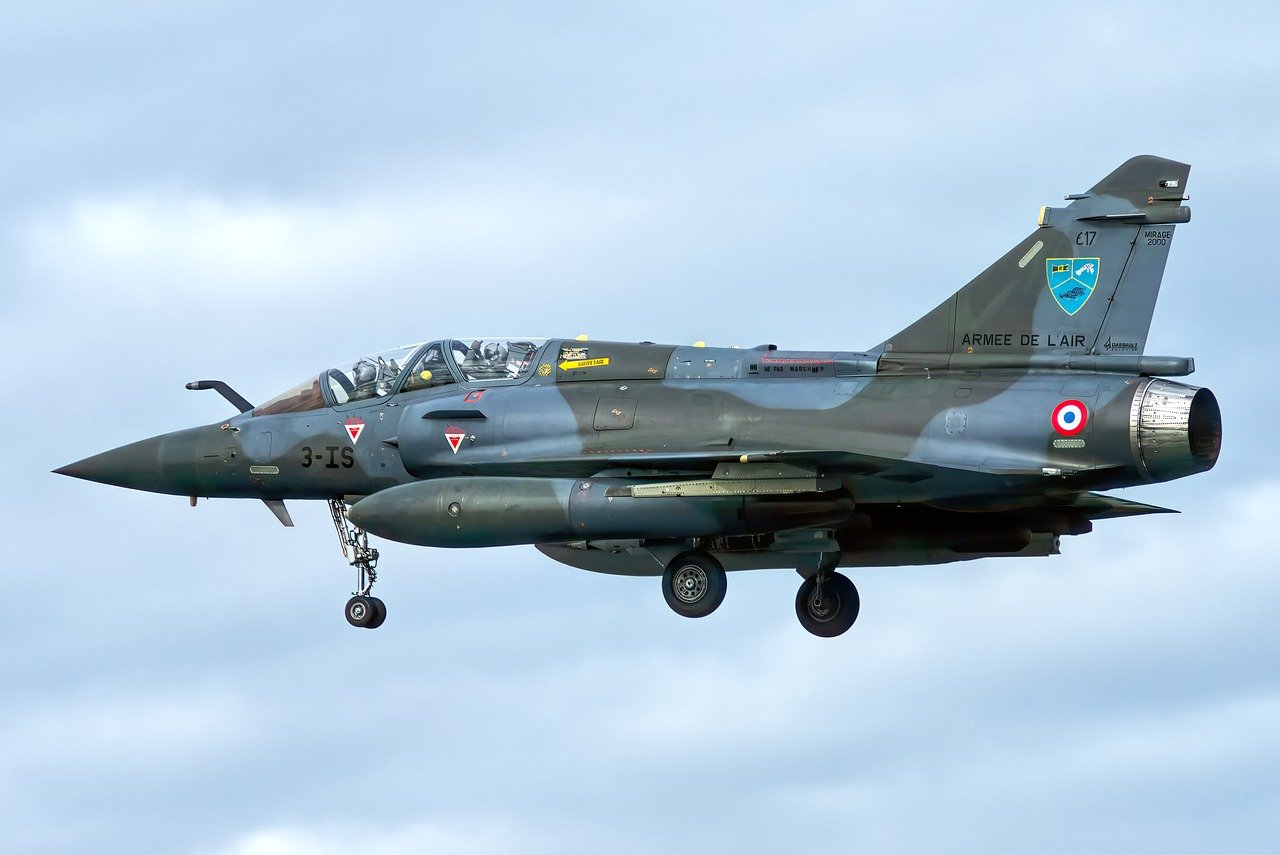
Real-Time Data Analysis
In the fast-paced world of military operations, has emerged as a game-changer, providing a crucial edge for decision-makers on the battlefield. Imagine being in a high-stakes game where every second counts, and the information you have can mean the difference between victory and defeat. This is the reality for military commanders who rely on AI systems to process vast amounts of data in real time, transforming raw information into actionable insights.
Modern military operations generate an overwhelming amount of data from various sources, including satellite imagery, reconnaissance drones, and ground sensors. The challenge lies in sifting through this information quickly and accurately. That's where AI comes into play. By employing sophisticated algorithms and machine learning techniques, AI can analyze data streams at lightning speed, identifying patterns and trends that might escape human analysts. This capability not only enhances the speed of decision-making but also improves the accuracy of the intelligence gathered.
One of the key benefits of real-time data analysis is its ability to provide commanders with a comprehensive situational awareness. When faced with rapidly changing conditions on the battlefield, having access to up-to-the-minute data allows military leaders to make informed decisions. For instance, AI systems can integrate data from various platforms, such as:
- Intelligence reports
- Weather conditions
- Enemy movements
- Logistical capabilities
By synthesizing this information, AI can present a clearer picture of the battlefield, enabling commanders to devise strategies that are both timely and effective. Furthermore, the predictive capabilities of AI can help anticipate enemy actions, allowing for preemptive measures that enhance operational readiness.
However, the integration of real-time data analysis in military operations is not without its challenges. One major concern is the quality of data being analyzed. If the input data is flawed or biased, the insights generated could lead to poor decision-making. Therefore, ensuring data integrity is paramount. Moreover, there is a need for continuous training of AI systems to adapt to the ever-evolving landscape of warfare, which can be resource-intensive.
In addition to these challenges, military leaders must also consider the human element in decision-making. While AI can provide valuable insights, it is ultimately up to human commanders to interpret these insights and make the final call. This raises questions about the balance between human intuition and machine analysis. How much reliance should be placed on AI, and at what point does it become a crutch rather than a tool?
To illustrate the impact of real-time data analysis, consider a hypothetical scenario where a military unit is engaged in a complex urban operation. With AI-powered systems in place, commanders can receive real-time updates on troop movements, identify potential ambush sites, and analyze civilian patterns to minimize collateral damage. The ability to process and act on this information swiftly can lead to a more successful outcome and save lives.
As we look to the future, the role of real-time data analysis in military operations will continue to evolve. With advancements in AI technology, we can expect even more sophisticated systems capable of handling larger data sets and providing deeper insights. The potential for enhanced situational awareness, improved operational efficiency, and increased safety for military personnel is vast.
- What is real-time data analysis in military operations? Real-time data analysis involves the immediate processing of data from various sources to provide actionable insights for decision-making on the battlefield.
- How does AI improve decision-making in military contexts? AI enhances decision-making by quickly analyzing large volumes of data, identifying patterns, and providing commanders with timely information for strategic planning.
- What are the challenges of implementing real-time data analysis? Challenges include ensuring data quality, the need for continuous training of AI systems, and balancing human intuition with machine-generated insights.
- Can real-time data analysis reduce risks in military operations? Yes, by providing comprehensive situational awareness and predictive capabilities, real-time data analysis can help military leaders anticipate threats and make informed decisions.

Predictive Analytics
In the realm of military operations, has emerged as a game changer, transforming how commanders approach decision-making. Imagine being able to foresee potential outcomes before they unfold, much like a chess player anticipating their opponent's moves several steps ahead. This capability is not just a theoretical concept; it is an active component of modern military strategy. By leveraging vast amounts of data, predictive analytics tools analyze patterns and trends to forecast future scenarios, enabling military leaders to make informed decisions that can significantly impact the success of their missions.
At its core, predictive analytics involves the use of algorithms and statistical models to analyze historical data and identify trends. This process is akin to piecing together a puzzle where each piece represents a different data point—be it troop movements, weather conditions, or enemy behaviors. By synthesizing these pieces, military planners can visualize potential outcomes and prepare accordingly. For instance, if data suggests a high probability of enemy engagement in a specific area, commanders can allocate resources and strategize effectively, ultimately enhancing operational readiness and response times.
One of the most compelling aspects of predictive analytics in military contexts is its ability to adapt in real-time. Imagine a battlefield where conditions can change in an instant; having a system that can process incoming data and adjust predictions accordingly is invaluable. AI-driven tools can analyze real-time intelligence, such as satellite imagery or drone surveillance, allowing military leaders to pivot strategies based on the latest information. This adaptability not only improves decision-making speed but also increases the likelihood of mission success.
However, it's essential to acknowledge that while predictive analytics offers significant benefits, it also presents challenges. The reliability of predictions hinges on the quality and accuracy of the data fed into the system. If the data is biased or incomplete, the predictions can lead to misguided strategies. Therefore, military organizations must invest in high-quality data collection and management systems to ensure that their predictive analytics tools are effective. Furthermore, training personnel to interpret and act on these predictions is crucial. After all, data is only as good as the decisions it informs.
In summary, predictive analytics is revolutionizing military decision-making by providing commanders with the foresight needed to navigate complex operational landscapes. By harnessing the power of data, military leaders can make informed choices that enhance strategic planning and operational readiness. As technology continues to evolve, the integration of predictive analytics will likely become even more sophisticated, reshaping the future of military operations.
- What is predictive analytics in military operations?
Predictive analytics involves using data analysis techniques to forecast potential outcomes and scenarios, helping military leaders make informed decisions. - How does predictive analytics improve decision-making?
By analyzing historical and real-time data, predictive analytics allows commanders to anticipate challenges and allocate resources effectively. - What challenges are associated with predictive analytics?
The effectiveness of predictive analytics depends on the accuracy of the data used. Biased or incomplete data can lead to poor decision-making. - How can military organizations ensure the reliability of predictive analytics?
Investing in quality data collection and management systems, along with training personnel to interpret data effectively, is essential for reliability.

Scenario Simulations
In the ever-evolving landscape of military strategy, have emerged as a game-changer. Imagine being able to step into a virtual environment where various combat situations can be visualized and tested without the real-world consequences. This is precisely what AI-driven scenario simulations offer to military leaders. By leveraging advanced algorithms and vast datasets, these simulations provide a platform for commanders to explore multiple outcomes based on different variables, creating a dynamic training ground that enhances strategic foresight.
These simulations are not just about role-playing; they are deeply analytical tools that can model the complexities of modern warfare. For instance, a military leader can simulate a scenario where enemy forces are using unconventional tactics. The AI can analyze historical data and current intelligence to predict how these tactics might unfold, allowing commanders to prepare more effectively. This predictive capability is crucial, as it enables armed forces to adapt swiftly to changing battlefield conditions, much like a chess player anticipating their opponent's moves.
Moreover, scenario simulations facilitate collaboration among various branches of the military. Imagine a joint exercise where the Army, Navy, and Air Force can all engage in a simulated environment, testing their interoperability. This collaborative approach not only strengthens operational readiness but also fosters a culture of innovation, as military personnel can experiment with new tactics and technologies in a risk-free setting.
However, the implementation of scenario simulations is not without its challenges. The accuracy of these simulations relies heavily on the quality of the data fed into the AI systems. If the data is biased or incomplete, the outcomes of the simulations could lead to flawed decision-making. Therefore, it is essential to continually refine the data inputs and algorithms used in these simulations to ensure they remain relevant and reliable.
Furthermore, as military operations become increasingly complex, the demand for more sophisticated scenario simulations grows. This requires ongoing investment in technology and training, as well as a commitment to integrating these tools into the broader military strategy. The benefits, however, are undeniable. By utilizing scenario simulations, military leaders can enhance their preparedness, make more informed decisions, and ultimately save lives on the battlefield.
- What are scenario simulations in military AI? Scenario simulations are advanced tools that allow military leaders to visualize and analyze various combat situations using AI technology, enabling better strategic planning and decision-making.
- How do scenario simulations improve military readiness? They allow commanders to test different tactics and outcomes in a risk-free environment, enhancing their preparedness for real-world operations.
- What are the challenges associated with scenario simulations? The accuracy of these simulations depends on the quality of data and algorithms used, which must be continually updated to ensure reliability.
- Can scenario simulations be used for joint military exercises? Yes, they facilitate collaboration among different military branches, allowing for joint exercises that test interoperability and strategic coordination.

Risk Assessment Models
In the ever-evolving landscape of military operations, powered by artificial intelligence have emerged as crucial tools for military planners. These models are designed to evaluate potential threats and vulnerabilities, allowing decision-makers to navigate the complexities of modern warfare with greater confidence. Imagine standing on a battlefield where the fog of war obscures your vision; AI risk assessment models act as a beacon, illuminating the path ahead by analyzing a multitude of variables that could impact mission success.
One of the most significant advantages of AI-driven risk assessment is its ability to process vast amounts of data in real-time. Traditional risk assessment methods often rely on historical data and human analysis, which can be time-consuming and prone to error. In contrast, AI systems can rapidly analyze data from various sources, such as satellite imagery, reconnaissance reports, and social media feeds, to provide a comprehensive overview of the operational environment. This capability not only enhances situational awareness but also enables commanders to make informed decisions based on current conditions rather than outdated information.
Furthermore, these models utilize advanced algorithms to identify patterns and correlations that might not be immediately apparent to human analysts. For instance, by examining historical conflict data, AI can predict potential flashpoints and assess the likelihood of escalation in specific regions. This predictive capability is invaluable for military leaders who must allocate resources effectively and prioritize missions based on the level of risk involved.
However, while the benefits of AI-based risk assessment models are significant, there are also challenges that need to be addressed. One major concern is the potential for bias in the algorithms used. If the data fed into these systems is skewed or incomplete, the resulting assessments may lead to misguided strategies or misallocation of resources. Therefore, it is imperative for military organizations to ensure that the data used in these models is diverse, accurate, and representative of the real-world complexities they aim to simulate.
Moreover, the reliance on AI for risk assessment raises questions about human oversight. While AI can enhance decision-making, it should not replace the critical thinking and judgment of experienced military leaders. A balanced approach that combines AI's analytical power with human insight is essential to mitigate risks effectively. This collaboration can be likened to a well-coordinated dance, where both partners play a vital role in achieving the desired outcome.
As military forces continue to integrate AI into their operations, the development of robust risk assessment models will play a pivotal role in shaping future strategies. By leveraging the strengths of AI, military planners can enhance their ability to anticipate threats, allocate resources wisely, and ultimately ensure mission success. The journey towards fully realizing the potential of AI in risk assessment is ongoing, but the progress made thus far is a testament to the transformative power of technology in the realm of defense.
- What are risk assessment models in military AI?
Risk assessment models are AI-driven tools that analyze data to evaluate potential threats and vulnerabilities in military operations, aiding decision-makers in strategic planning. - How does AI improve risk assessment?
AI enhances risk assessment by processing vast amounts of real-time data, identifying patterns, and providing actionable insights that traditional methods may overlook. - What are the challenges of using AI in risk assessment?
Challenges include potential bias in algorithms, the need for accurate data, and ensuring human oversight remains integral to the decision-making process. - Why is human oversight important in AI-driven risk assessments?
Human oversight is crucial to ensure that AI-generated insights are interpreted correctly and that strategic decisions reflect a comprehensive understanding of the operational context.

Autonomous Systems
In the realm of modern warfare, are revolutionizing the way military operations are conducted. These systems, which include drones, robotic vehicles, and unmanned ground systems, are not just tools; they are becoming integral components of military strategy. Imagine a battlefield where decisions can be made in the blink of an eye, where machines analyze data and execute missions with precision that far surpasses human capabilities. This is the reality that autonomous systems are ushering in, and it’s both exciting and daunting.
One of the most significant advantages of using autonomous systems is their ability to operate in high-risk environments without putting human lives on the line. For instance, drones can conduct surveillance, gather intelligence, and even engage in combat without a pilot in the cockpit. This capability allows military forces to extend their reach and effectiveness while minimizing casualties. However, the reliance on these machines raises questions about decision-making speed and accuracy. Can a machine make the right call in a split second, or will it falter under pressure?
Moreover, the integration of artificial intelligence into these systems enhances their operational capabilities. AI algorithms enable autonomous vehicles to analyze vast amounts of data in real-time, allowing them to adapt to changing conditions on the battlefield. For example, an autonomous drone can adjust its flight path based on detected threats, optimizing its mission without human intervention. This level of agility is crucial in fast-paced combat situations, where every second counts.
However, with great power comes great responsibility. The use of autonomous systems also introduces a host of ethical dilemmas. Questions arise about accountability: if an autonomous drone makes a mistake that leads to civilian casualties, who is responsible? The operator? The manufacturer? Or the AI itself? Establishing clear lines of accountability is essential to ensure that these powerful tools are used responsibly and ethically.
Furthermore, the potential for bias in algorithms is a significant concern. AI systems learn from data, and if that data is flawed or biased, the decisions made by these systems may also be flawed. This could lead to unintended consequences on the battlefield, further complicating the already intricate nature of military operations. Thus, it is imperative that military organizations prioritize transparency and fairness in their AI development processes.
As we look to the future, the role of autonomous systems in military operations will only grow. Their ability to process information and execute tasks with unparalleled speed and accuracy makes them invaluable assets. However, it is crucial for military leaders to navigate the challenges that accompany these advancements, ensuring that ethical considerations and accountability measures are at the forefront of their implementation.
- What are autonomous systems in the military?
Autonomous systems refer to unmanned vehicles and drones that can operate independently or with minimal human intervention, performing tasks such as surveillance, reconnaissance, and combat. - How do autonomous systems enhance military operations?
They provide real-time data analysis, reduce human risk in dangerous environments, and execute missions with high precision and speed. - What are the ethical concerns surrounding autonomous systems?
Major concerns include accountability for mistakes, potential biases in decision-making algorithms, and the moral implications of using machines in warfare. - Will autonomous systems replace human soldiers?
While they will augment military capabilities, the complete replacement of human soldiers is unlikely due to the need for human judgment in complex scenarios.

Ethical Considerations
As we plunge deeper into the realm of military applications for artificial intelligence, the surrounding its use become increasingly significant. Imagine a world where decisions about life and death are made by algorithms rather than humans; it’s a thought that sends shivers down the spine. The integration of AI in military decision-making processes raises critical questions about accountability, bias in algorithms, and the moral implications of deploying autonomous systems in warfare.
One of the primary concerns is the issue of accountability. Who is responsible when an AI system makes a mistake? Is it the programmer, the military leadership, or the machine itself? This ambiguity can lead to a dangerous lack of oversight. As military operations become more reliant on AI, it’s crucial to establish clear lines of accountability. Without these, we risk creating a situation where mistakes can be easily brushed aside, leading to devastating consequences.
Furthermore, the potential for algorithmic bias is a pressing ethical dilemma. AI systems learn from data, and if the data fed into these systems is biased, the outcomes will be as well. This can perpetuate existing inequalities and lead to unfair treatment of certain groups, especially in conflict situations. The military must ensure that the data used to train AI systems is representative and free from bias to avoid these pitfalls.
Additionally, the use of autonomous systems in warfare raises profound moral questions. For instance, can a machine truly understand the nuances of human life and the complexities of combat? The idea of machines making life-and-death decisions challenges our fundamental understanding of morality and ethics in warfare. As we advance in AI technology, we must grapple with these moral responsibilities and consider the implications of allowing machines to engage in combat.
To address these ethical challenges, the military must implement robust oversight mechanisms. This includes regular audits of AI systems, transparency in how decisions are made, and a framework for accountability that can respond to failures. Moreover, it’s essential to foster an ongoing dialogue among military personnel, ethicists, and policymakers to navigate the murky waters of AI in warfare effectively.
On a broader scale, the international community faces the challenge of establishing regulations that govern the use of military AI. As nations race to develop advanced AI technologies, the lack of global norms could lead to an arms race that prioritizes speed over ethical considerations. Establishing international agreements on the use of AI in military contexts is essential to ensure that ethical standards are upheld globally.
| Ethical Issues | Description |
|---|---|
| Accountability | Determining who is responsible for AI-driven decisions. |
| Algorithmic Bias | The potential for AI systems to perpetuate existing inequalities. |
| Moral Responsibility | Understanding the implications of machines making life-and-death decisions. |
| Oversight Mechanisms | Implementing systems to ensure accountability and transparency in AI use. |
| International Regulations | Establishing global norms for the use of military AI technologies. |
In conclusion, the ethical implications of AI in military decision-making are vast and complex. As we continue to innovate and integrate these technologies into our armed forces, it’s vital to remain vigilant about the ethical considerations at play. The future of warfare may depend on our ability to navigate these challenges responsibly.
- What are the main ethical concerns regarding military AI? The main concerns include accountability for decisions made by AI, the potential for algorithmic bias, and the moral implications of using autonomous systems in warfare.
- How can accountability be ensured in AI decision-making? Establishing clear lines of responsibility, conducting regular audits, and fostering transparency in decision-making processes are essential steps.
- What is algorithmic bias and why is it a problem? Algorithmic bias occurs when AI systems produce unfair outcomes due to biased training data, which can perpetuate inequalities in military operations.
- Are there international regulations governing military AI? Currently, there is a lack of comprehensive international regulations, highlighting the need for global agreements to ensure ethical standards are maintained.

Accountability and Oversight
As military organizations increasingly turn to artificial intelligence for decision-making, the question of accountability and oversight becomes paramount. The integration of AI in military operations can enhance efficiency and effectiveness, but it also introduces a host of ethical dilemmas that cannot be ignored. Who is responsible when an AI system makes a mistake? Is it the programmer, the military commander, or the machine itself? These questions are not just theoretical; they have real-world implications that can affect lives and international relations.
To address these concerns, it is essential to establish robust accountability frameworks that delineate responsibilities clearly. This includes implementing policies that require human oversight in AI decision-making processes. While AI can analyze vast amounts of data and provide recommendations faster than any human, the final decision should ideally rest with a qualified individual who can consider the broader context, ethical considerations, and potential consequences of their actions. After all, as advanced as AI may be, it lacks the nuanced understanding of human emotions and moral judgment.
Moreover, oversight mechanisms should be put in place to monitor AI systems continuously. This can involve regular audits and assessments to ensure that the algorithms are functioning as intended and are free from biases that could skew their outputs. For instance, if an AI system is trained on historical data that reflects past prejudices, it may inadvertently perpetuate those biases in its decision-making processes. To mitigate this risk, military organizations must invest in diverse datasets and employ teams of experts to evaluate AI outputs critically.
In addition to internal oversight, there is a growing call for external accountability measures. Independent bodies could be established to review military AI applications and their outcomes. This transparency would not only foster public trust but also ensure that military actions align with international humanitarian laws and ethical standards.
As we navigate this complex landscape, it’s vital to engage in ongoing dialogue among military leaders, policymakers, ethicists, and the public. By fostering a culture of accountability and openness, we can harness the power of AI in military decision-making while minimizing the risks associated with its use.
In summary, accountability and oversight in military AI are not just about compliance; they are about ensuring that technology serves humanity responsibly. As we advance further into the age of AI, the principles of accountability must evolve alongside technological capabilities to ensure that we do not lose sight of our moral obligations.
- What are the main concerns regarding AI accountability in the military? The primary concerns include determining who is responsible for AI decisions, ensuring that AI systems are free from bias, and maintaining human oversight in critical decision-making processes.
- How can military organizations ensure AI systems are unbiased? By using diverse datasets for training AI models and regularly auditing these systems for bias, military organizations can work towards minimizing the risk of biased outcomes.
- What role do external bodies play in AI oversight? External bodies can provide independent reviews of military AI applications, ensuring transparency and adherence to ethical standards and international laws.
- Why is human oversight crucial in AI decision-making? Human oversight is essential to incorporate ethical considerations, contextual understanding, and accountability, which AI systems currently lack.
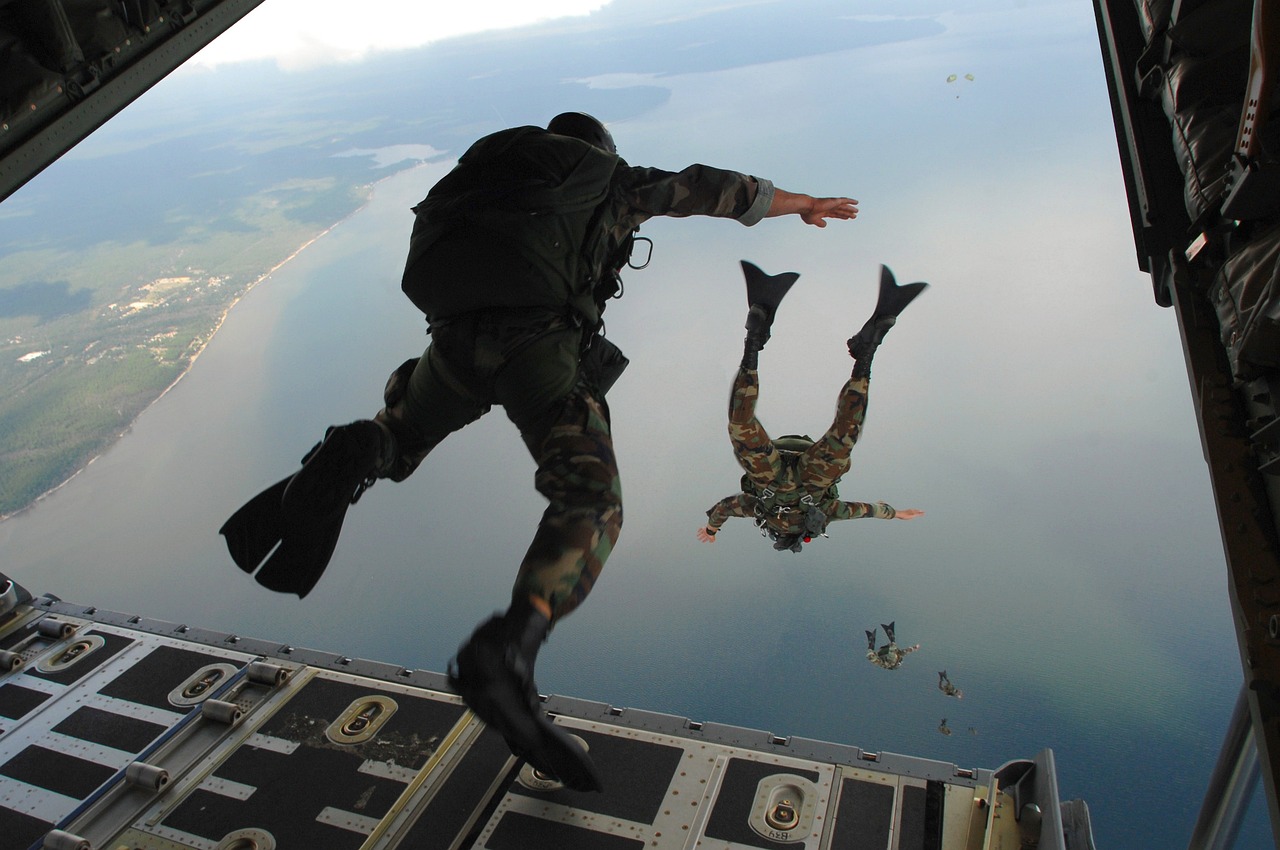
International Regulations
The rapid advancement of artificial intelligence (AI) in military applications has sparked an urgent need for that can govern its use. As nations race to integrate AI into their armed forces, the absence of a cohesive framework can lead to significant ethical dilemmas and security risks. The challenge lies not just in creating rules, but in ensuring that they are adhered to globally. Imagine a world where one country employs AI-driven autonomous weapons without oversight, while another adheres strictly to ethical standards; the potential for conflict is staggering.
Currently, various international organizations are grappling with how to approach these regulations. The United Nations, for instance, has initiated discussions around the need for treaties that would manage the development and deployment of military AI systems. However, these discussions are often bogged down by differing national interests and the complexities of technological capabilities. Countries like the United States and China are at the forefront of AI military applications, making it difficult to establish a common ground.
To illustrate the current landscape, consider the following table that outlines key international efforts and their objectives:
| Organization | Objective | Status |
|---|---|---|
| United Nations | Develop a treaty for autonomous weapons | In progress |
| European Union | Establish ethical guidelines for AI in defense | Proposed |
| International Committee of the Red Cross | Ensure compliance with humanitarian law | Active discussions |
One of the most pressing issues in establishing these regulations is the diversity of perspectives on what constitutes ethical AI use in military contexts. For instance, while some countries advocate for strict regulations to prevent misuse, others argue that such limitations could hinder national security. This divergence complicates the creation of universally accepted standards.
Furthermore, the technological pace at which AI is evolving adds another layer of complexity. By the time regulations are drafted, the technology may have already advanced beyond the scope of those regulations. As a result, there is a growing call for a more flexible regulatory framework that can adapt to ongoing technological changes.
In light of these challenges, it’s essential for nations to engage in continuous dialogue and collaboration. Building trust among countries can pave the way for more effective regulations, ensuring that AI technologies are used responsibly and ethically in military operations. After all, the stakes are high, and the implications of unchecked AI development could lead to unforeseen consequences on a global scale.
- What are the main challenges in regulating military AI? The main challenges include differing national interests, the rapid pace of technological advancement, and the complexity of establishing universal standards.
- Why is international cooperation important for military AI regulations? International cooperation is crucial to ensure that all countries adhere to ethical standards, preventing conflicts and misuse of AI technologies.
- What role do organizations like the UN play in regulating military AI? Organizations like the UN facilitate discussions and negotiations among member states to create treaties and guidelines for the ethical use of military AI.
Frequently Asked Questions
- What are the key benefits of integrating AI into military decision-making?
Integrating AI into military decision-making offers numerous benefits, including enhanced efficiency, improved accuracy, and faster processing of vast amounts of data. AI can analyze real-time information, providing actionable insights that help commanders make informed decisions quickly. This can lead to better outcomes in complex and rapidly changing combat situations.
- How does real-time data analysis impact military operations?
Real-time data analysis is crucial in military operations as it enables armed forces to respond swiftly to dynamic battlefield conditions. AI systems can sift through enormous datasets, identifying patterns and trends that human analysts might miss. This capability allows for timely decision-making, which is often the difference between success and failure in military engagements.
- What role do predictive analytics play in military strategy?
Predictive analytics play a significant role in military strategy by forecasting potential scenarios and outcomes based on historical data and current intelligence. By utilizing these tools, military leaders can plan more effectively, preparing for various contingencies and ensuring operational readiness in the face of uncertainty.
- How are scenario simulations used in military training?
AI-driven scenario simulations are utilized in military training to create realistic combat environments where leaders can visualize and practice responses to various situations. These simulations enhance preparedness and strategic foresight, allowing military personnel to refine their tactics and decision-making processes before facing real-world challenges.
- What ethical concerns arise from using AI in military operations?
There are several ethical concerns regarding the use of AI in military operations, including accountability for decisions made by autonomous systems, potential biases in algorithms, and the moral implications of deploying AI in warfare. Addressing these concerns is vital to ensure responsible and ethical use of technology in military contexts.
- What mechanisms are needed for accountability in AI decision-making?
To ensure accountability in AI decision-making, robust oversight mechanisms must be established. This includes clear guidelines on the use of AI in military operations, regular audits of AI systems, and protocols for human oversight. These measures help prevent unintended consequences and ensure that military actions remain aligned with ethical standards.
- Are there international regulations governing military AI applications?
Yes, there are ongoing discussions about international regulations governing military AI applications. However, establishing global norms and agreements is challenging due to the rapidly evolving nature of AI technology and differing national interests. Collaborative efforts are essential to create a framework that addresses the unique challenges posed by military AI.











